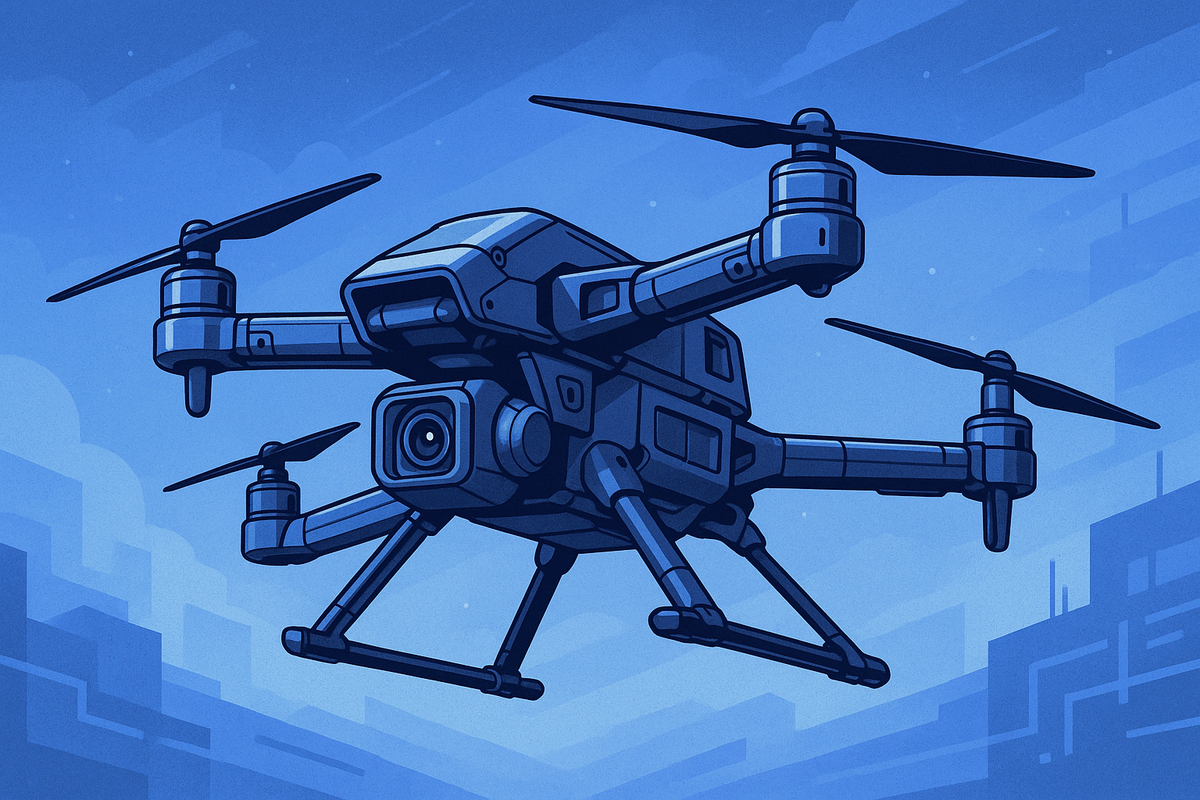SkyTech Orion Global (CTGL): Disrupting the Global Defense Industry with Rapid-Prototyped Modular Military Drones

Military doctrine is shifting in real time. The war in Ukraine has shown the world that drones are now frontline weapons, altering battlefields and rewriting procurement strategies. The problem for Western defense contractors is obvious. Current systems are too expensive, too slow to adapt, and too dependent on foreign parts, particularly Chinese supply chains.
An answer is emerging. Modular, soldier-deployable drones built with advanced plastics, designed to be assembled in the field, and priced at an author estimated $10,000 per unit, strike a balance between military-grade durability and commercial affordability that the market has never seen before. At the center of this revolution is SkyTech Orion Global Corp (CTGL), a U.S. company with an Israeli subsidiary. Backed by intellectual property in the form of UMV patents for modular drone design, SkyTech is preparing to take a leadership role in this new era, and it plans to scale rapidly through a forthcoming listing on the NYSE or NASDAQ.
Materials and Design: Why Hi-Tech Plastics Matter
For decades, drones were constructed like aircraft, with heavy metals, machined aluminum, and complex parts that limited scale and flexibility. That approach is no longer viable. The frontier today is hi-tech plastics and composites that are lighter, stronger, and cheaper to mass-produce. BlueHalo’s Intense Eye IE-V3 already proved the concept by moving from machined aluminum to HX5 thermoplastic polymers from Alpine Advanced Materials. The results were striking, with a seven-to-one parts consolidation ratio and significant improvements in strength-to-weight performance.
SkyTech’s intellectual property extends these advantages further. Its patented modular designs allow airframes to be injection-molded with advanced plastics, then combined with interchangeable components that make the drones simultaneously lighter, stronger, and dramatically less expensive. Just as important is motor placement. Many SkyTech configurations use the under-propeller or “pusher” design, which keeps rotors out of the camera’s line of sight, increases ground clearance for sensitive sensors, and improves airflow efficiency. For intelligence, surveillance, and reconnaissance missions, unobstructed sensor views can mean the difference between success and failure.
Manufacturing Landscape: Rapid Prototyping vs Injection Molding
Much attention has been given to 3D printing, but the reality is that no major Western defense company relies on rapid prototyping for large-scale drone production. General Atomics prints thousands of components annually, but these are small, specialized parts such as cable pass-throughs and air inlets. Anduril has promoted its “software-defined manufacturing,” but it remains dependent on conventional materials and commercial parts. BlueHalo has demonstrated the promise of injection molding, but has not taken the leap into modular soldier-level platforms.
SkyTech Orion Global is the only known defense company pursuing 90–100% rapid manufacturing for its drone platforms. Every part of the system, with the possible exception of the central AI brain module, is designed for rapid manufacturing rather than conventional injection molding. This is a revolutionary capability. Rapid manufacturing enables localized production close to the battlefield, ensuring that warfighters can access and replace parts in days rather than months. It also allows soldiers to carry and assemble the drones themselves, at the edge of combat, with systems weighing less than two pounds. This “patent-pending LEGO-style” modularity is what makes SkyTech unique in the Western defense landscape.
The economics explain why. Additive manufacturing is invaluable for development and testing, but costs rise quickly once production scales beyond a few hundred units. Injection molding, especially with advanced plastics, becomes far more efficient at thousands or tens of thousands of units. SkyTech understands this equation and embraces a hybrid model. Its production combines rapid prototyping for development and field-deployable parts with injection molding for airframes and core structures. This means SkyTech can deliver both flexibility for front-line adaptation and scalability for mass procurement.
The Modular Concept: A True Game Changer
The U.S. military has made clear that every squad will have drone capabilities in the near future. Current systems, however, are fractured. One drone performs surveillance. Another handles strike missions. A third delivers logistics support. Each requires separate training, logistics, and supply chains, driving up costs and slowing deployment.
SkyTech solves this inefficiency with its patented LEGO-style modular system. Soldiers can assemble drones in the field without engineers or factory support. Missions can be transformed within minutes by swapping out motors, arms, or payloads, shifting a drone from reconnaissance to attack or to resupply as needed. A persistent AI brain module retains learning and software no matter how the configuration changes, ensuring seamless performance. Command and control can also operate at multiple levels, with soldiers in direct control but with higher-level override through AI arbitration. Because components can be manufactured locally with injection molding or rapid prototyping, supply chains remain sovereign and independent from Chinese influence.
The lessons from Ukraine are unambiguous. Soldiers on the ground are already improvising, soldering commercial drones into makeshift attack platforms. SkyTech’s patented approach delivers that same adaptability, but with military durability and professional-grade design.
The Pricing Breakthrough: Economics of Mass Deployment
Price is the critical variable. At present, U.S. military tactical drones like the RQ-11 Raven cost between $35,000 and $40,000 apiece. Newer Army programs are projected to exceed $120,000 per drone. By contrast, Ukraine has been able to produce one million FPV drones annually for as little as $400 to $2,000 each, but those systems lack the ruggedness and reliability required by Western militaries.
SkyTech’s price point should land directly in a sweet spot. We believe that an optimized price point of approximately $10,000 per modular drone would maximize SkyTech’s business prospects, balancing affordability with profitability. The company itself has not confirmed this figure.
It delivers military-grade performance at a cost low enough to allow mass deployment. At this level, procurement budgets stretch dramatically further. The U.S. market alone could absorb 25,000 to 50,000 units annually. Europe could demand another 15,000 to 25,000 units, while Asia-Pacific allies such as Japan, South Korea, and Australia might require an additional 10,000 to 20,000. Altogether, that represents 50,000 to 95,000 drones per year across Western allies, and a total addressable market of $538 billion.
The economics are impossible to ignore. NATO cannot afford to continue firing $200,000 missiles to shoot down $11,000 Russian drones. Affordable, attritable, modular drones are the only sustainable answer.
Competitive Landscape: Why SkyTech Stands Alone
Every defense technology company now claims to be part of the drone revolution, but their limitations are clear. Anduril has scale and software but remains focused on single-purpose designs. General Atomics is a leader in composites and additive manufacturing, but it has not delivered true soldier-level modularity. BlueHalo has pioneered injection molding with HX5 polymers, but its platforms are not designed for field reconfiguration.
SkyTech Orion Global stands apart because it combines what others cannot. It is a U.S. company with Israeli collaboration. It holds intellectual property in the form of UMV patents that define modularity in this sector. And with an author estimated price point of $10,000, it offers a model that no other Western contractor has approached. And it does all of this without relying on Chinese parts or supply chains. This is not an incremental advance. It is a step change.
Strategic Market Entry and Momentum
The timing could not be better. The Pentagon’s 2025 “Unleashing Drone Dominance” policy now allows colonel-level procurement authority, fourteen-day certification, and direct soldier-level modification of platforms. Special Operations Command is actively seeking modular solutions through its “Drone in a Box” program. Europe has launched the €800 billion ReArm initiative to expand domestic defense production. The U.S. Army has announced that every unit will be equipped with drones by 2026.
Furthermore, Western governments have drawn a clear line: no drones, components, or supply chains tied to China, Russia, North Korea, or Iran. That reality disqualifies the low-cost commercial alternatives flooding global markets. SkyTech’s U.S./Israeli design and patent-pending modular system positions it as one of the few truly competitive Western solutions.
SkyTech is positioning itself at the intersection of these trends. With a planned NYSE or NASDAQ listing, it will have the capital base to scale production and secure a leadership role in the next phase of military transformation.
A Generational Investment Opportunity
The future of military drones will not be defined by $120,000 boutique aircraft. It will be defined by $10,000 modular platforms that soldiers can assemble, reconfigure, and replace without breaking procurement budgets. SkyTech Orion Global (CTGL) is the only company combining hi-tech plastic airframes, patented modular design, Israeli collaboration, and mass affordability.
This is a generational investment opportunity. The total addressable market is $538 billion. The urgency is immediate. The technology is proven. The geopolitical environment demands rapid adaptation.
Disclosure: I own shares of the company and may buy or sell shares at any time without prior notice. This statement is not a recommendation to buy or sell securities and reflects my personal investment decisions.





